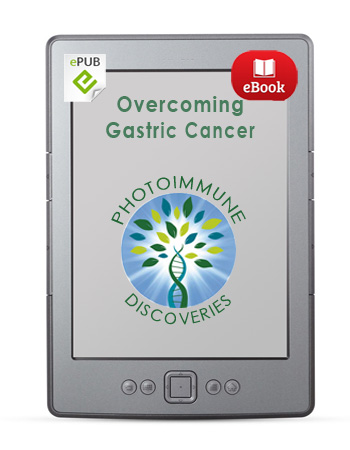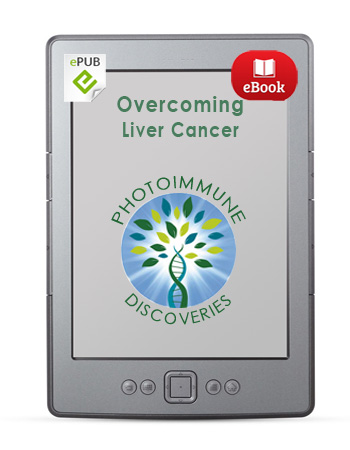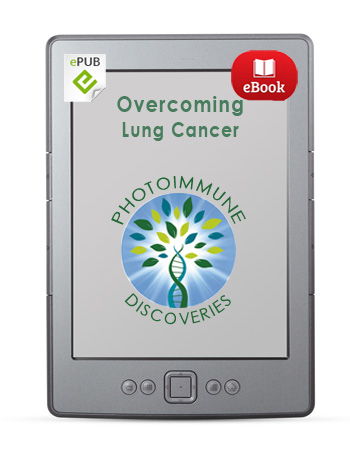Description
Overcoming Stomach Cancer
The Promise of Photodynamic Therapy and Other Innovative Therapies
Stomach cancer, also known as gastric cancer, is one of the most frequent and lethal cancers. It is the second most common cause of cancer death worldwide and has the fourth highest incidence, with approximately 830,000 new cases diagnosed each year. The disease tends to strike adults after they have reached their fifties and sixties, with peak occurrence among adults (mostly men) in their early seventies. The most common type of stomach cancer, gastric adenocarcinoma, accounts for nearly 95% of all stomach cancer cases.
Part 1 of this ebook provides an overview of the different types of stomach cancer, the main risk factors, and standard diagnostic and treatment methods. At the present time, surgery is considered to be the most effective treatment for stomach cancer, as long as the cancer has not yet spread beyond the stomach. The exact choice of surgical procedure is based on the location and growth pattern of the tumor, as well as on the anticipated location of lymph node metastases.
For early-stage stomach tumors, five-year survival rates may be as high as 90%. For patients with advanced stomach cancer, however, relapse is a virtual guarantee following “curative” surgery, with 70% of patients relapsing within two years after surgery, and more than 90% relapsing within five years. Once a relapse occurs, no curative treatment is available, and the median survival is only about six months.
Part 2 discusses the various benefits of light-sensitizing treatments, or photodynamic therapy (PDT), as well as other photomedical applications, notably photodynamic diagnosis (PDD). Part 3 considers promising future directions for research on these innovative therapies, while Part 4 lays out the long-term control strategies that can help keep melanoma from developing and progressing into a life-threatening disease.
An excerpt from the book:
“PDT is technically more difficult to use in the case of stomach cancer due to the stomach’s rather unique anatomy and physiology, which is beyond the scope of this book. On the other hand, although PDT is somewhat limited in its ability to treat deep lesions, it can be quite effective in treating the smaller and more superficial stomach lesions that are characteristic of early stomach cancer. This range of efficacy helps explain why PDT has produced a complete remission rate of 60%–100% in several clinical studies of early stomach cancer patients in Japan and Korea…
“In a pilot clinical trial, Viktor Romanov and colleagues studied 65 patients with mainly early-stage stomach cancer (average age: 70 years old) who were treated using the photosensitizer Bremachlorin®. Of this group, 50 patients were at a high risk of post-surgical complications, five patients had rejected surgery, and 10 patients were in palliative care due to the advanced nature of their disease. A total of 264 photodynamic treatment sessions were performed, and each patient received from one to 23 sessions, with treatments taking place over a five-year period. During this time, a biopsy was done twice a year, then once a year for the next five years.
“The most effective PDT treatment schedule was found to be three sessions in the first year and two sessions in each of the subsequent years. Two patients with the most severe forms of stomach cancer received 23 treatments each and have stayed alive for eight years at the time of this writing. Every patient responded in some way to the treatment, and the overall treatment benefit during the first five years for every patient can be summarized as follows:
• 35% had a complete response
• 49% had a partial response
• 15% showed disease stabilization
• 1% showed disease progression
“Thirty percent of the patients had recurrences of their tumors and were treated repeatedly, without any serious side effects. Some patients complained of symptoms related to the rapid breakdown of the tumor tissues. These symptoms included pain in the upper central region of the abdomen (epigastrium), as well as nausea and toxic effects that were managed using standard medications and techniques. The findings from this study were presented at the 14th World Congress of the International Photodynamic Association, which was held in May 2013 in Seoul, South Korea.”
Lastly, photodynamic diagnosis (photodiagnosis) may play a central role in the detectio of early-stage cancer. By detecting these early, superficial lesions in the stomach lining, photodiagnosis could provide vital information for anyone hoping to avoid the eventual development of stomach cancer. This information can be used to help alert you, the patient, to the need to be more aggressively proactive in your efforts to ward off cancer, perhaps using a combination of nutritional, herbal, and innovative medical strategies.
The ebook’s appendix includes a special discussion about two light-sensitizing substances, a dietary supplement called Bremachlorophyll, and a unique medicine called Bremachlorin. Because of its diverse effects against cancer, Bremachlorin-PDT is likely to revolutionize the way Photomedicine is incorporated into modern cancer treatment. Bremachlorin-PDT has already demonstrated impressive benefits for patients with stomach cancer, as shown in Part 2 of this ebook.






 English
English Français
Français Deutsch
Deutsch Nederlands
Nederlands